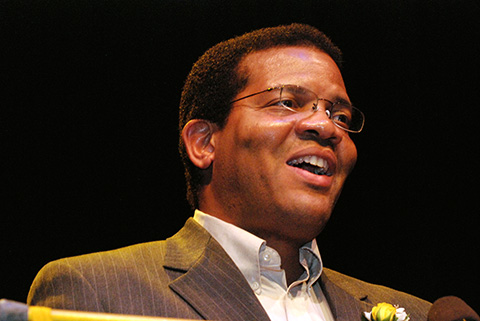From New Ideas to Common Practices:
How Can Experimental Programs Become Standard Operating Procedure?
What does a flu outbreak have in common with a rash of gang violence?
Perhaps surprisingly, the answer is quite a few things—for example, the way they spread. Just as something as transmittable as the flu moves through a community, so can gang violence; in other words, both are contagious. As with disease, there are preventative measures that can be taken that may affect the ultimate outcome of an incidence of gang violence. In addition, each relies on a variety of data to explore and document the problem. Also, both can be tackled more effectively if a variety of partners are engaged in finding a solution.
 Toward that end, the COPS Office, the California Endowment (a private health foundation whose mission is to expand access to affordable, quality health care to under served communities and improve the overall health of all Californians), and the Center for Court Innovation (whose purpose is to help the justice system aid victims, reduce crime, strengthen neighborhoods, and improve public trust in justice), are convening a series of roundtable discussions to identify opportunities for collaboration between law enforcement and public health officials. A new publication from The California Endowment, the Center for Court Innovation, and the COPS Office called Seeding Change • How Small Projects Can Improve Community Health and Safety, provides a summary of the second roundtable discussion, as well as the projects hoping to break new ground in finding a solution to violence in communities across the country.
Toward that end, the COPS Office, the California Endowment (a private health foundation whose mission is to expand access to affordable, quality health care to under served communities and improve the overall health of all Californians), and the Center for Court Innovation (whose purpose is to help the justice system aid victims, reduce crime, strengthen neighborhoods, and improve public trust in justice), are convening a series of roundtable discussions to identify opportunities for collaboration between law enforcement and public health officials. A new publication from The California Endowment, the Center for Court Innovation, and the COPS Office called Seeding Change • How Small Projects Can Improve Community Health and Safety, provides a summary of the second roundtable discussion, as well as the projects hoping to break new ground in finding a solution to violence in communities across the country.
Violence is increasingly being viewed as a major public health issue. Anthony B. Iton, Senior Vice President of Healthy Communities at the California Endowment says, “Tell me your zip code, and I’ll tell you how long you’re going to live.” Also, violence, injuries, disabilities, and early death come with an incredibly expensive price tag—financially, physically, and emotionally—in some of this country’s most disadvantaged communities.
At the end of the first roundtable (held in Los Angeles in March 2011) The California Endowment offered participants the chance to apply for mini-grants for collaborative projects (nine jurisdictions were ultimately awarded $10,000 grants). At the second roundtable, held in Washington, D.C., in January 2012, some of those awardees presented progress reports on their projects, as members of funding institutions listened and offered feedback and insight on what makes a particular program attractive to a funder.
 In speaking about the roundtable discussions, Iton said “As a former director of a county health department, I know first-hand how a partnership between the health department and the police department can strongly reinforce each other’s efforts toward safety and health. We can do much more together than each could do individually.”
In speaking about the roundtable discussions, Iton said “As a former director of a county health department, I know first-hand how a partnership between the health department and the police department can strongly reinforce each other’s efforts toward safety and health. We can do much more together than each could do individually.”
And Joshua Ederheimer, Acting Director of the COPS Office, added, “As law enforcement agencies across the country watch their budgets shrink, it’s critical that these agencies think creatively about new programs, new ways of delivering service, and alternative funding methods. This project is a terrific example of how a few creative ideas an serve as the launching pad for major innovations.”
With regard to what they heard at the second roundtable, Barbara Raymond, Director of Schools and Neighborhoods for the California Endowment, said, “We were surprised at how much work had been done with relatively small investments. We were surprised by the power of the mini-grants. The problems are so big, but you start where you are—you seed a number of different projects and see what makes sense for a community, then you can do a deeper dive.”
The efforts of the communities have been varied and promising. For example, East Palo Alto, California, is struggling with significant public safety and public health issues. While the city’s violent crime rate is twice as high as the state’s average, life expectancy of its residents is significantly shorter than the rest of the county. With the support of The California Endowment, the East Palo Alto Police Department is trying a new approach.
First, the department is using gunshot location detection system (GLDS) technology to identify shooting hot spots. These areas are then designated as “FIT Zones.” Officers are assigned to these areas to get fit—to walk, run, and bike ride—with area residents. Ideally, the program will allow residents to take back the streets—a combination of a new police presence, along with growing numbers of people out and about, sends a message that this is now a healthy, safe neighborhood. The program also forms the basis for a host of potential new partnerships that may include law enforcement, public health officials, community-based organizations, and others.
In Milwaukee, the grant is being used to develop a data system where information about fatal and near-fatal violent crime can be organized and analyzed. The Milwaukee Homicide Review Commission (a collaboration involving criminal justice professionals and community service providers that seeks to better understand homicides, help solve cases, and reduce the number of killings) is working with the Milwaukee Police Department to combine information-sharing and data-driven strategies. The model is already being shared with other jurisdictions.
The Chicago Police Department has used its mini-grant to create a new collaborative working group with Chicago’s public health agencies. Specifically, the police department’s data collection system is being refined to allow for public health data elements. A very old data warehouse is being updated and plans are for the department to continue to explore ways police and public health can work together, including expanding a project called Safe Start that helps children exposed to violence.
The Los Angeles Police Department has launched a Community Safety Partnership in four housing developments. They put their seed money toward creating a training module to familiarize police with the department’s data system, and particularly focused on the 50 officers working in those housing developments. The system also includes public health data.
All of these projects represent a model that roundtable participants hope will continue. Funders suggested that law enforcement and public health agency partnerships could gain funding opportunities that neither might be able to take advantage of if they were working alone. And with ever-tightening budget climates, every advantage helps.
 Raymond says the timing is right for public health/public safety partnerships. “I think we’re hitting a moment,” Raymond says, “where it’s becoming more intuitive that violence is truly a public health issue. Public health has often used a criminal justice approach in tackling problems. It’s gratifying to see that criminal justice stakeholders are now realizing the value a public health approach can bring to their own challenges.”
Raymond says the timing is right for public health/public safety partnerships. “I think we’re hitting a moment,” Raymond says, “where it’s becoming more intuitive that violence is truly a public health issue. Public health has often used a criminal justice approach in tackling problems. It’s gratifying to see that criminal justice stakeholders are now realizing the value a public health approach can bring to their own challenges.”
Iton agreed, saying “We know that many of our community safety problems are caused by underlying health issues, such as substance abuse and mental health issues. Health—and the lack of it—is the major driver of crime and violence. Knowing this, the next logical step would be to apply the best tool for the job and ask ourselves: how do we use health solutions to solve what are basically health problems? I love this conversation because it makes us realize that if we address health, we will address crime.”
Hate Crime Reporting | New Ideas to Common Practices | MSP Youth Leadership Academy | Helping Hartford Prosper | 2013 L. Anthony Sutin Civic Imagination Award | IACP and CSCP Award

